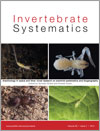
Invertebrate Systematics
Volume 28 Number 4 2014
Arachnology in Space and Time: Novel Research on Arachnid Systematics and Biogeography
IS13051Molecular phylogenetics of Caribbean Micrathena (Araneae : Araneidae) suggests multiple colonisation events and single island endemism
One of the most intriguing questions in island biogeography is how organisms colonise archipelagos and diversify within and among islands. We studied patterns of colonisation and speciation in the spider genus Micrathena, finding that Caribbean ancestors likely arrived 20–35 million years ago over a land bridge, and subsequently new species formed on each island, resulting in many island endemics. This work highlights preliminary evidence of the roles of rare dispersal coupled with island vicariance in generating the unique Caribbean Micrathena fauna.
IS13057The first phylogenetic analysis of Palpigradi (Arachnida) – the most enigmatic arthropod order
Palpigradi are a group of minute arachnids, often found in caves or other subterranean habitats. Concomitantly, a phylogenetic tree has eluded researchers for decades. Here we present a phylogeny of palpigrades based on specimens from different subterranean habitats. Analyses of three molecular markers found monophyly of Palpigradi and Eukoeneniidae, the latter divided into four main clades, three including samples from multiple continents.
IS14004From Gondwana to Europe: inferring the origins of Mediterranean Macrothele spiders (Araneae : Hexathelidae) and the limits of the family Hexathelidae
The European spiders of the genus Macrothele are of conservation concern and uncertain origins, with the closest relatives restricted to the Old World tropics. We uncover their phylogenetic relationships and colonisation pathways into the Mediterranean. Our results suggest that the present-day genus distribution reflects the tectonic movements following the Gondwana break-up and that the two European endemics colonised the Mediterranean basin independently.
IS13058Barcoding of mygalomorph spiders (Araneae : Mygalomorphae) in the Pilbara bioregion of Western Australia reveals a highly diverse biota
The Pilbara bioregion of Western Australia contains vast mineral deposits and unique ecosystems. To assess mygalomorph diversity, DNA barcoding sequences were obtained from 1134 specimens; these data provided evidence of numerous new species, resulting in an increase in species richness of 191%. This study shows that barcoding provides a rapid, objective method to help quantify mygalomorph species identifications and distributions.
IS14005Molecular phylogenetic analysis of Western Australian troglobitic chthoniid pseudoscorpions (Pseudoscorpiones : Chthoniidae) points to multiple independent subterranean clades
The subterranean aquatic fauna of the Western Australian calcrete aquifers has been well studied; however, little is known about the subterranean terrestrial fauna. We found that two subterranean terrestrial pseudoscorpion genera display similar patterns to the aquatic fauna, in that each calcrete aquifer generally contains its own discreet lineages, with evidence for multiple subterranean incursions into the aquifers. This supports the theory that these aquifers have been isolated for millions of years, with little to no gene flow occurring between them.
IS14009Phylogeography and species delimitation in the New Zealand endemic, genetically hypervariable harvestman species, Aoraki denticulata (Arachnida, Opiliones, Cyphophthalmi)
Aoraki denticulata, a widespread mite harvestman endemic to the NW South Island of New Zealand, was postulated to constitute an old lineage with deep genetic history. Expanding on previous studies, we explored its phylogeography and diversification patterns. Our results show high geographic structure and low genetic connectivity among modern populations, depicting the deep evolutionary history of the A. denticulata lineage.
IS14010Evolution of host use, group-living and foraging behaviours in kleptoparasitic spiders: molecular phylogeny of the Argyrodinae (Araneae : Theridiidae)
Spiders in the subfamily Argyrodinae are known for their associations with other spiders as web usurpers, spider predators or kleptoparasites, including approximately 20 group-living kleptoparasitic species. Our Bayesian phylogenetic analysis indicates the most likely evolutionary scenario is from free-living predatory behaviour→ araneophagy → a single origin of kleptoparasitism, and that group-living behaviour is associated with specialisation on large hosts.
IS13050On the New World spiders previously misplaced in Leptopholcus: molecular and morphological analyses and descriptions of four new species (Araneae : Pholcidae)
The phylogenetic relationships of Caribbean and South American spiders traditionally assigned to the genus Leptopholcus have long been unclear. We studied morphological and molecular characters of representatives from three Caribbean islands and from Brazil and found strong evidence for a closer relationship with Micropholcus than with Leptopholcus. Our results support the idea that identical microhabitats (such as the undersides of leaves as in the spiders studied) may result in potentially misleading convergences.



